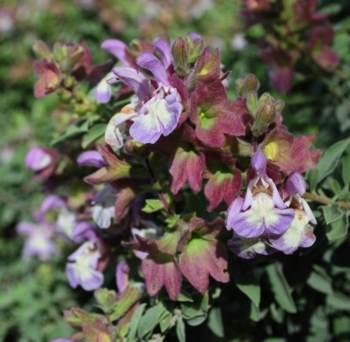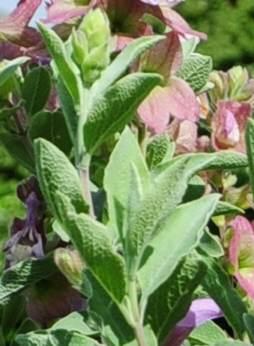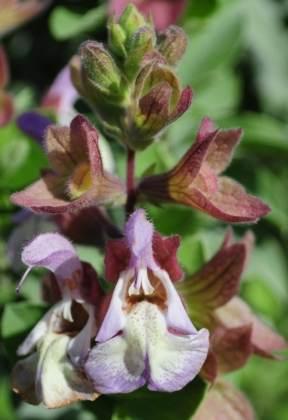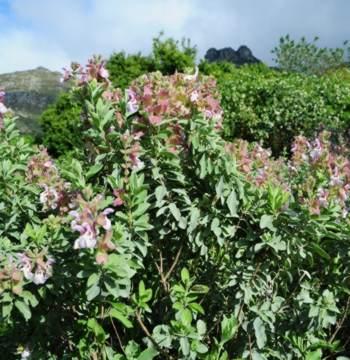Salvia dolomitica
Salvia dolomitica Codd
Family: Lamiaceae
Common names: dolomite sage, pilgrim's rest pink sage (Eng.); dolomietsalie (Afr.)
Introduction
The dolomite sage is the perfect, hardy, frost tolerant shrub for every garden which will reward its gardener with its long summer display and aromatic foliage.

Description
Description
Salvia dolomitica is a hardy, fairly fast growing, neat upright shrub, 1-2 m high. It branches from a basal rootstock-like stem and the diameter expands, over time, to form a thicker bush. Short, simple and glandular hairs adorn the stems.

Simple, aromatic leaves are a fresh green when young and age to an attractive dusty grey-green. They are usually shaped like a flattened egg, with sharp tips and a wedge-shaped base; their margins are entire. The leaves are densely covered with fine grey hairs and oppositely arranged.
The flowers are shaped in the typical sage family style with the two-lipped corolla. The upper lip is narrow and arches gracefully downwards while the lower lip is open and flattened. The flowers are multicoloured, the lilac and white corolla is usually complemented by yellow throat markings. Flowers Spring to mid-Summer (Sept.-Feb.). The calyx remains after flowering and turns a deep pinkish-purple, lengthening the display potential, until the nutlets forming within it ripen and fall out, after which the calyx then dries out and falls off. Four dark brown nutlets, each containing a single seed, are produced and are slimy when wet.

Conservation Status
Status
Salvia dolomitica is not threatened.
Distribution and habitat
Distribution description
The dolomite sage is restricted to the provinces of Limpopo and Mpumalanga, where it occurs at altitudes of 1150-1900 m on dolomite rock outcrops.
Derivation of name and historical aspects
History
Pliny the Elder, a Roman scientist and historian, was the first to use the name Salvia.
The virtues of sages can been found in old herbals with woodcuts and engravings from medieval and Renaissance Europe, giving medicinal recipes or describing charms or spells. Although grown in gardens for a long time, Salvias have been popular since the 1970's for ornamental gardening.
Salvia is derived from the Latin salvus, meaning uninjured, whole, safe, well or sound and salvere , to be in good health, referring to the medicinal value of the plants.
Salvia is the largest genus in the Lamiaceae familyand consists of approximately 900 species made up of annuals, perennials and shrubs. They are widely distributed around the world in warm temperate and tropical regions. 27 species are found naturally in South Africa. Noteworthy South African sages are Salvia lutea, S. africana, S. chamelaeagnea, S. muirii and S. thermarum. Sages are commonly grown as ornamentals.
The appellation dolomitica refers to this plant's association with its known habitat found only on dolomite rock.
Ecology
Ecology
Salvia dolomitica is one of the older South African sages, still adapted to bee pollination. The flattened lower lip of the flower provides a landing area for the bee. As the bee probes for nectar, it is dusted with pollen when it presses against the hinged filament of the stamen. Thus it can carry pollen from flower to flower and cross-pollination occurs. Most other Cape species have evolved longer tubular flowers, over time, to accommodate bird pollination, possibly due to their extended natural distributions. See Salvia lanceolata article for further details on bird pollination.
Uses
Use
The dolomite sage can be used as an attractive, summer-flowering shrub in any herbaceous border and is suitable for large or small gardens. This sage is a wonderful addition to any garden planting with its fresh, pleasantly aromatic foliage which can be complemented by other shrubs, herbaceous perennials or fynbos. It will also add a calm grey hue, with its abundant flowers, to a summer garden display. It is suitable as a foreground or background planting.
Although not highly recommended as a pot plant, they can make good container specimens if grown in large, well-drained pots. Salvia dolomitica is a wonderful garden specimen, frost-hardy and water-wise.

Growing Salvia dolomitica
Grow
Salvia dolomitica is best grown in open ground in full sun, but will tolerate light partial shade. It is best grown in well-drained, composted soils. The dolomite sage will survive with little water, but responds well to regular watering, especially in summer. No extra feeding is necessary for strong, healthy growth in good soils, although an occasional foliar feed would do no harm and the plants will tolerate and respond well to general fertilizing. The plants need to be pruned back hard every year or alternatively every second year to encourage bushy, non-woody growth. This is best done in late winter, prior to its new spring growth.
Young plants are planted out at the end of spring. Salvia dolomitica is easily combined with most flowering perennials or shrubs which contrast with its grey foliage, such as Diascia integerrima, Pelargonium citronellum and Orphium frutescens.They also give good contrast with fynbos plants such as Restionaceae, Proteaceae and Erica species.
New plants are easy to propagate from seed and cuttings.
Sow seeds late spring and early summer into general potting soil mix. Seeds germinate quickly and seedlings can be transplanted into well-drained potting soil once the first pair of true leaves appears.
Take semihardwood tip cuttings in spring and summer. Cuttings must be without terminal flowering buds. A rooting hormone would improve the chance of root development. Place in rooting medium: 50% fine-milled bark and 50% polystyrene (perlite, vermiculite, river sand and peat are alternatives). Keep cuttings under mist or enclose in plastic bag to retain humidity. Keep warm but out of direct sunlight. Cuttings should root in 2-4 weeks.
Due to the hairy and aromatic leaves the plants do not have any major pest, although mealy bug may settle near the base of the stems and leaves.
References
- Hedge, I.C. 1974. Revision of Salvia in Africa including Madagascar and Canary Islands. Notes from the Royal Botanic Garden Edinburgh 33(1).
- Smith, C.A. 1966. Common names of South African plants. Memoirs of the Botanical Survey of South Africa No. 35.
Credits
Monique McQuillan
Kirstenbosch National Botanical Garden
April 2013
Plant Attributes:
Plant Type: Shrub
SA Distribution: Limpopo, Mpumalanga
Soil type: Sandy, Clay, Loam
Flowering season: Spring, Early Summer, Late Summer
PH: Acid, Alkaline, Neutral
Flower colour: Pink, Mauve/Lilac
Aspect: Full Sun, Morning Sun (Semi Shade), Afternoon Sun (Semi Shade)
Gardening skill: Average
Special Features:
Horticultural zones











Rate this article
Article well written and informative
Rate this plant
Is this an interesting plant?
Login to add your Comment
Back to topNot registered yet? Click here to register.